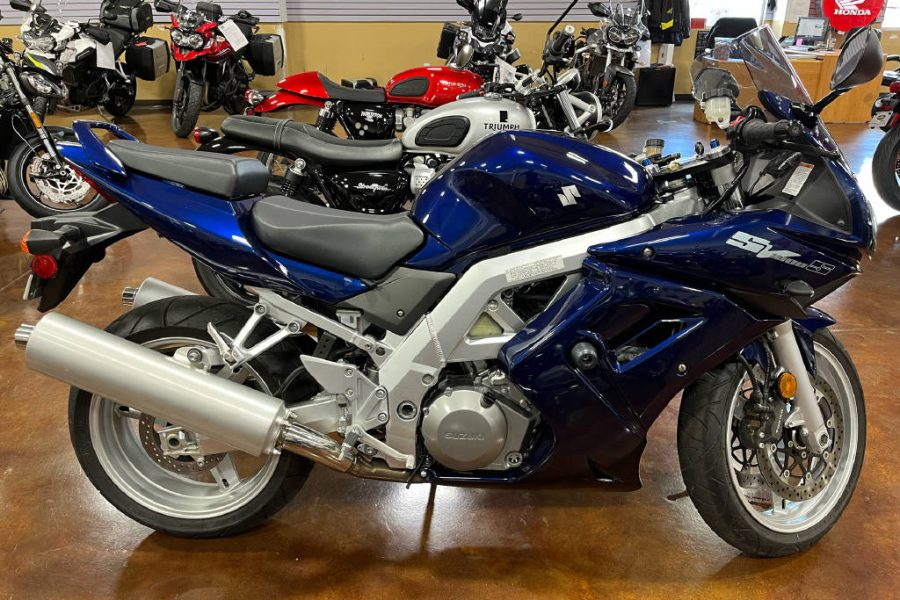Life is filled with mysteries. Whoreallyshot JFK? How to they make Caramilk bars? Who let the dogs out? And why wasn’t the Suzuki SV1000 series a success?
If you take a measured, thoughtful look at the SV1000 and SV1000S, those bikes should have been long-term successes, pillars of Suzuki’s lineup for 20 years. That’s how Suzuki does things, after all. Instead, this series lasted about a half-decade, and then disappeared into obscurity. What happened? Did the moto-public (as is so often the case) just not know what was good for it? Or were these bikes haunted by a cursed heritage?
要么way, it’s too late now, they’re gone, after a 2003-2007 run—and years on the used market seems to have somewhat removed their best advantage, the bang-for-buck quality.
- Photo: Freewheeling Powersports
- Photo: Freewheeling Powersports
Descendant of the TL1000
The SV1000 series debuted as a more sensible street-biased alternative to superbikes on the market of the early 2000s. This was ground Suzuki had explored before, with the RF900R. This time, instead of remixing its trusty inline four formula, Suzuki took the liquid-cooled V-twin from the TL1000 series and put it in a new chassis, with aluminum frame. It looked an awful lot like the SV650, which had already been in Suzuki showrooms for a few years.
The naked SV1000 and half-faired SV1000S came to market in 2003 with fuel injection and a claimed 120 horsepower at the crank, with 75 pound-feet of torque. It had linear power delivery, and while journos of the time didn’t try out-do each other in superlatives praising the bike, they seemed to reckon that engine was well-suited to real-world riding. Even at its launch, with a history in the TL1000, everyone knew this engine’s capability. But was the SV1000’s popularity held back by the TL series’ unfair reputation for questionable chassis? Perhaps.
Or maybe the problem was just that, in the early 2000s, cruisers and choppers and other customs had grabbed a lot of the bike-buying public’s attention? If you were into sporty bikes, then there was so much turnover and development in the world of crotch rocketeering that a more sensible machine like the SV1000 fell by the wayside. Even in Suzuki’s own lineup, the SV1000 competed against the cruder Bandit series, which has certainly earned itself much more of a reputation over the years, and could be tuned and built to produce a lot more power than the SV1000.
Then again, the SV650 certainly didn’t struggle on the sales floor with the Bandit 600/650 as competition. The SV650 is still here today, and still reckoned an absolute classic, almost 30 years after its debut. So why not the SV1000? Even here on the forum, there area few threads about the SV1000, but most of them are not very long. Perhaps the bike is best summed up by this thread, with the titleSV1000; do they exist?!?!.

Photo: Freewheeling Powersports
Buying an SV1000 now?
第一个问题是,你想要的裸体SV1000, which was only sold in the US for 2003, or the SV1000S? The S came with a half-fairing wrapped around the headlight, and a belly-pan. Later versions of the bike also came with extra bodywork bolted on for a full-faired look. Contemporary reviews really liked that version of the machine when it came out; generally, journos preferred the SV1000S, even though it came with lower-mounted handlebars. The naked version was more of a hooligan, but that made it less fun at highway speeds.
So what to look for? These machines have an excellent rep for long-term durability. As long as there are no leaks, and the clutch doesn’t sound like it’s ready to grenade, the bike will probably last as long as it’s properly maintained and not abused. Some owners report issues with the “green connector” that ties the ignition circuit into the main wiring harness (this may sound familiar to V-Strom 1000 owners, who have reported similar issues).
Oh yeah—and sometimes the charging system will throw magnets. The good news is, all these problems are fairly easy to check for, and if you keep on top of maintenance, you can generally stop these from becoming issues after you buy the machines.

Photo: Freewheeling Powersports
This bike here?
The machine here is a 2004 SV1000S with a full fairing, arguably the most desirable configuration. TheGeorgia-based dealership’s adlists these details: “Seat height reduced 20mm for more comfortable rider seating position, plus lowered subframe for more comfortable passenger seating.” The rear fender is also trimmed down. And there’s this note: “THIS USED MOTORCYCLE HAS A REBUILT TITLE WITH ODOMETER DISCREPANCY.”
So that’s why the mileage is listed at a low, low 4,975 miles? You’d want to straighten that whole situation out, before putting any money down. Make sure your insurer is willing to work with you on this machine, too. Some companies don’t like rebuilt titles. And, it probably wouldn’t hurt to negotiate on the price; they’re asking $5,499, which sounds absolutely mad for an 18-year-old sportbike with a salvage title. But who knows—maybe, if you see this bike in person, it’s obviously worth the money? Itdoeslook quite clean. Let us know, if you pop by the dealership to take a look …









